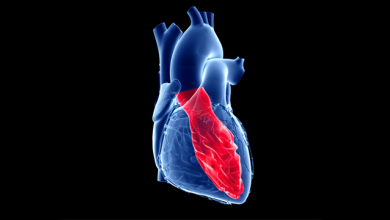Search results
Author(s):
Nilofer Sorathia
,
Hussein Al-Rubaye
,
Benham Zal
Added:
3 years ago
Statins are most frequently prescribed for the primary prevention of cardiovascular disease due to their lipid-lowering properties. They are known to exert their effect by competitive inhibition of 3-hydroxy-3-methylglutaryl coenzyme A (HMG-CoA) reductase. The reduction in the synthesis of cholesterol induces upregulation of LDL receptors in the liver, resulting in increased clearance and…
View more
Author(s):
Alessandro Pingitore
,
Giorgio Iervasi
,
Francesca Forini
Added:
3 years ago
Cardioprotection includes all methods and mechanisms that lead to the reduction in infarct size, and is thus involved in the evolution of post-ischaemic heart failure (HF). This is a growing research issue since ischaemic heart disease is the leading cause of morbidity and mortality worldwide. A key challenge for these studies is the unravelling of cardioprotection complexities such as the…
View more
Inflammation in Diabetes
Author(s):
Sotirios Tsalamandris
,
Alexios S Antonopoulos
,
Evangelos Oikonomou
,
et al
Added:
3 years ago
Article
Author(s):
Christos-Konstantinos Antoniou
,
Panagiota Manolakou
,
Nikolaos Magkas
,
et al
Added:
3 years ago
Cardiac resynchronisation therapy (CRT) has been a cornerstone in the treatment of select advanced heart failure cases since its introduction to our armamentarium in the early 2000s.1 Indeed, 30–60% of advanced heart failure patients exhibit evidence of dyssynchrony, when defined electrocardiographically or mechanically.2–4 The latter is a consequence of the former. CRT has several unique…
View more
Author(s):
Dennis V Cokkinos
,
Christos Belogianneas
Added:
3 years ago
The term cardiac remodelling (REM) is used to define changes that produce geometrical rearrangement of the normal structures of the heart, together with complex biological and molecular alterations. REM affects the heart at the level of the cardiomyocyte, the blood vessels and the extracellular matrix. Proliferation of the latter, resulting in fibrosis, is one of the hallmarks of pathological REM…
View more
Author(s):
Amelia Carro
,
Josefa María Panisello
Added:
3 years ago
Dietary Patterns
Several studies correlate healthy dietary patterns with lower plasma concentrations of pro-inflammatory markers.1 These healthy dietary patterns support greater benefits than the potential effects of a single nutrient supplementation. The current body of evidence shows that healthy dietary patterns share similarities, shown in Figure 1.2 These features fit with the report of the…
View more
Author(s):
Gaetano Antonio Lanza
,
Hiroaki Shimokawa
Added:
11 months ago
Author(s):
Domenic A Sica
Added:
3 years ago
Introduction
Diabetes mellitus is rapidly increasing in its worldwide prevalence and is currently estimated to affect 7-8% of the US population.1 In 2005, 1.5 million new cases of diabetes were diagnosed in people aged 20 years or older in the US. In the not-so- distant past, type-2 diabetes mellitus was viewed as a seemingly benign condition, at least in the elderly, with little effect on life…
View more
Author(s):
Peter J Fitzgerald
,
Martin B Leon
Added:
3 years ago
An unintended consequence of the market success of drug-eluting stents has been a growing concern about their safety and safety-related costs. These devices have been so quickly and widely adopted that their market penetration already equals that of some of the most popular pharmaceutical drugs. Consequently, the absolute significance of even a low incidence of side effects becomes magnified by…
View more
Author(s):
Peter J Fitzgerald
,
Martin B Leon
Added:
3 years ago
An unintended consequence of the market success of drug-eluting stents has been a growing concern about their safety and safety-related costs. These devices have been so quickly and widely adopted that their market penetration already equals that of some of the most popular pharmaceutical drugs. Consequently, the absolute significance of even a low incidence of side effects becomes magnified by…
View more














